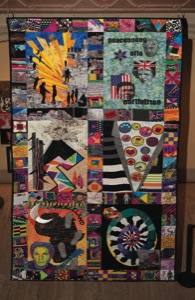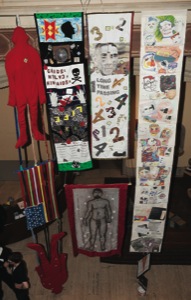
To quote the great Steven Sondheim, (via Barbra Streisand) “A vision’s just a vision if it’s only in your head … It has to come to life!” That was certainly the case when the San Diego Museum of Art accepted The Quilt Conversation, my summer-long project proposal about AIDS and the 1980s that involved quilting, contemporary dance and improvisational performance. I say this because I had no experience with any of those art forms. It takes a village and I was going to have to reach out to the community to help make this vision breathe.
But then the The Quilt Conversation falls into a genre of art called social practice which is defined as person-to-person exchange, interaction, or participation, a kind of relationship-based activity not unlike the camaraderie that evolved during the AIDS crisis that changed the country and knitted the LGBT community together in ways we haven’t seen since. The camaraderie of the AIDS crisis years led to significant change on social and medical fronts but it also generated the NAMES Project AIDS Memorial Quilt, a memorial and a monument to that period of time.
With that (and Barbra) in mind, this column is dedicated to the generous, creative, big-hearted artists who spent this past summer putting The Quilt Conversation together … week by week; part by part; sheet by sheet; art by art.
Kurt Cunningham led me to Wendy Sue Biegeleisen. Wendy Sue volunteered at The LGBT Center back in the 1980s where she initiated the quilt-making workshop in San Diego and therefore spent many hours helping people make panels to commemorate loved ones lost to AIDS. Wendy chose not to make a panel to historicize her own experience of the 1980s. Rather she chose to do in 2012 what she did twenty-five years ago: sit quietly helping those who needed assistance, offering sewing advice, providing feedback, listening and laughing at our catty gay jokes.
John Keasler is one of the volunteer administrators of the Art of Pride. Month after month he helps promote the work of a local LGBT artist. John was eager to participate in this project. He offered his home for some pre-museum brainstorming and he was busting with ideas right from the start, many of them stretching the meaning of a quilt in very welcome ways. John invited his friend Richard Greene to participate. Richard brought to the table a great deal of enthusiasm and an archive of drawings left to him by participants of AIDS Art Alive, a group that he ran that used art as a way of dealing with diagnosis and death. Dick’s panel consists of countless self-portraits in crayon and magic marker of people who are no longer with us. It is seriously profound.

I asked local artist and arts educator Kevin Greeland to participate as soon as my project was accepted. I didn’t know if he had much experience making quilts but I knew we could all rely on his good sense and creative sensibility if things ever got away from us. They didn’t but we ended up with Kevin’s stunning sheer and red panel nonetheless, a panel that he and Wendy Sue began and finished while the rest of us were still deep in the weeds brainstorming and panicking. James Glunt made a stunning panel too. James joined our merry quilt making posse at the last minute. He had a sewing machine so he spent many Friday’s stitching everyone’s ideas together until he had an idea of his own. James’ quilt incorporates a disco ball and images of Crisco and poppers. It mimics the cheeky grin James brought to the museum right through the summer, one that reminded us all of the fun we once had. Too much fun!
Finally, if The Quilt Conversation is about history then it relies upon memory and if our collective memory of the 1980s inhabited a person that would be Anthony Gioffre. I received an email from Anthony early on in the process. He heard that I was looking for participants and he had experience folding quilts in an official capacity for the NAMES Project ceremonies. Even though Anthony admitted to having no strong artistic skills he steeped us and museum visitors in vivid stories about Fire Island and Studio 54 reminding us all how his generation stepped up to bat when action was required, and still do. As his stories flowed, so too did his ideas until a panel emerged that reflected his life in the crisis.
“A vision’s just a vision if it’s only in your head.” And so this one began to come to life!
Much like anything that happens in the LGBT community, artistic and otherwise, The Quilt Conversation came to life thanks to the collective efforts of individual strangers with a common experience. Wendy Sue, John, Anthony, Dick, Kevin and James worked alongside Ann Olsen and her team of quilters from other communities and Aug. 31 their recorded quilt-making conversations will be re-presented by a cast of seven performers in a grand finale at the museum. Those performers will take scraps of reality and recording and try to put it all back together “beat by beat; part by part; sheet by sheet; chart by chart.”
Come meet the quilters and the performers, see the quilts and watch the performance at the San Diego Museum of Art Friday at 7 p.m., the finale of The Quilt Conversation and the museum’s Summer Salon, 2012!











